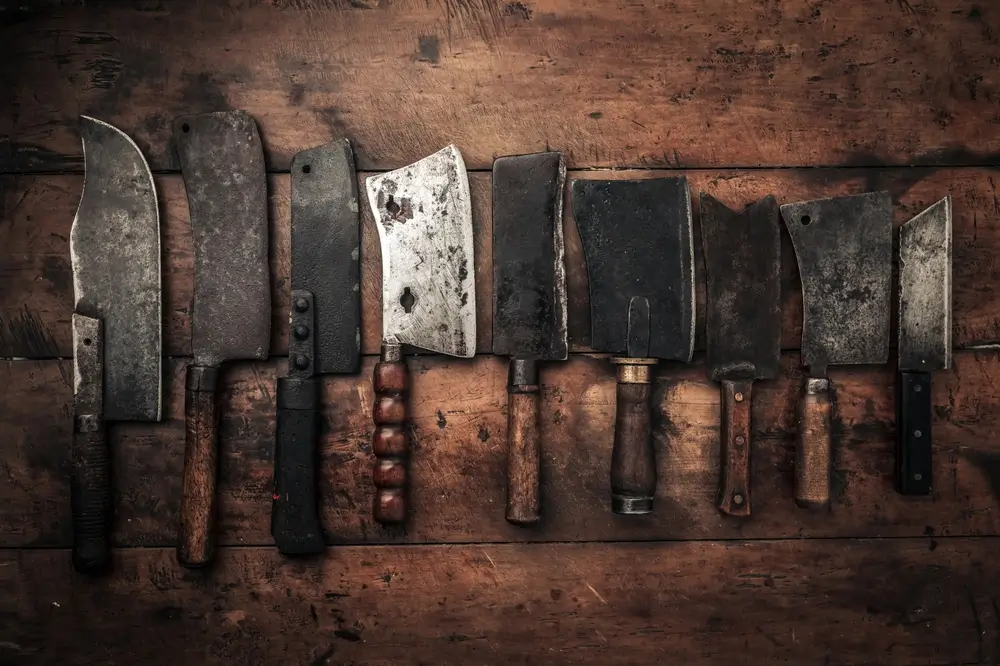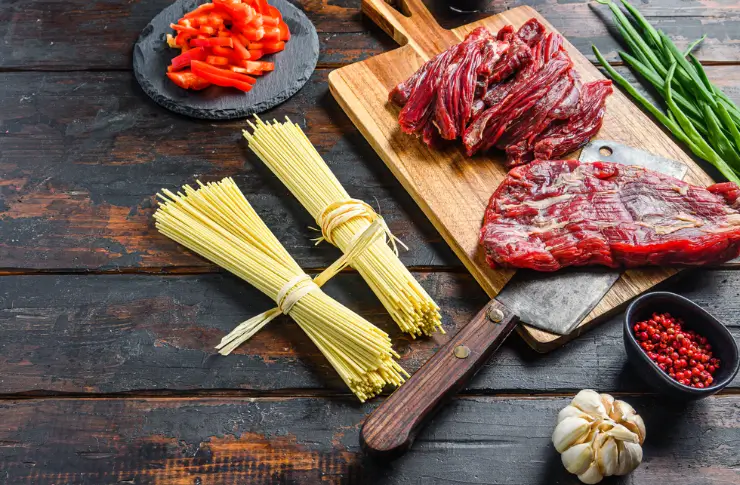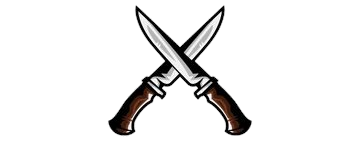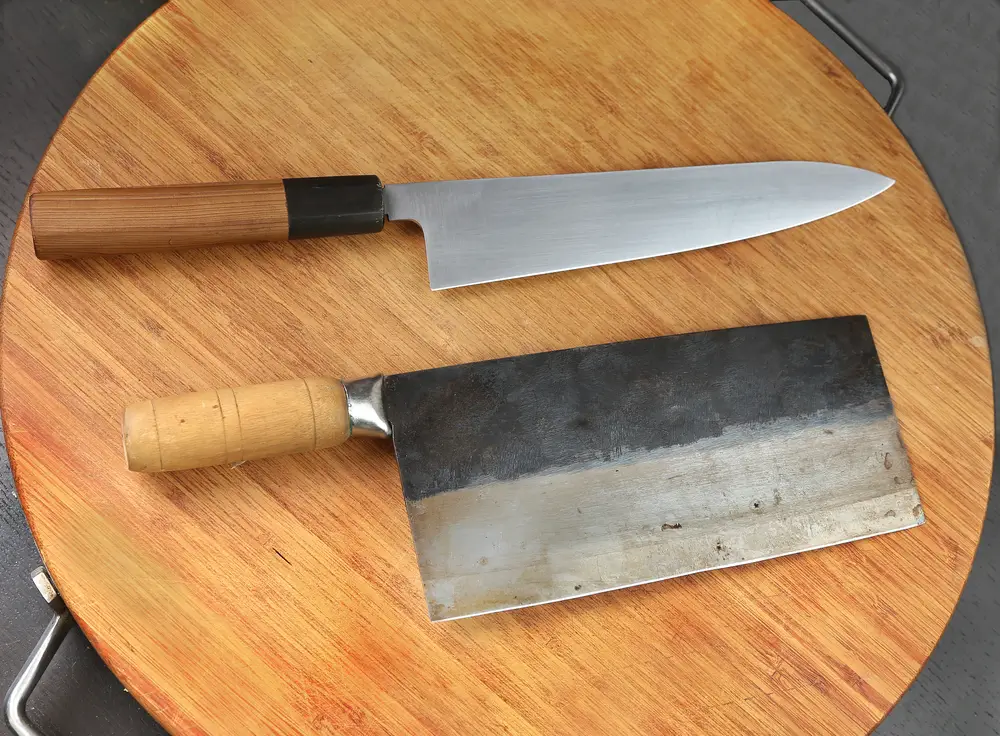Japanese Cleaver Types: You’ve seen Japanese cleavers in kitchen stores and you’re curious about them, but you don’t know what to look for or if they’re worth the investment. With all of the different types, brands, and prices of Japanese cleavers it can be hard to decide if they’re right for you.
We’ve written this guide to help make your decision easier. In it, we’ll discuss the different types of Japanese cleavers, their features, and what to consider when making your purchase. After reading this guide you’ll have a better understanding of which type of Japanese cleaver is best for your needs.
The Japanese Cleaver Knife
A Japanese cleaver knife is a type of knife that is designed for general-purpose slicing and chopping. The blade is usually heavy and thick, making it ideal for mincing and dicing meat and vegetables. Japanese cleaver knives are also known for their durability and sharpness. In fact, many professional chefs prefer to use them because they make quick work of prep work!
History of Japanese Cleaver Knives

Japanese cleaver knives have a long and storied history. Originally used for warfare, these deadly weapons were soon adapted for use in the kitchen. Today, Japanese cleavers are prized for their versatility and sharpness and are an essential tool in any chef’s arsenal.
Japanese cleavers first came into use during the Acheulean period and then in the Kamakura period (1185-1333). These early knives were heavy and thick, with a wide blade that was ideal for hacking through armor. However, as warfare changed and armor became less common, the Japanese cleaver began to evolve. By the Muromachi period (1338-1573), these knives had become thinner and lighter, with a narrower blade that was better suited for slicing. It was during this time that the Japanese cleaver began to be used in the kitchen.
Today, Japanese chefs prize their cleavers for their versatility. The wide, thin blade is ideal for chopping vegetables, while the sharp edge can easily handle delicate tasks like slicing fish. In addition, the weight of the knife makes it easy to chop through bone, making it an indispensable tool in any kitchen. Whether you’re a professional chef or a home cook, a Japanese cleaver is a knife that you’ll reach for again and again.
Tips to Best Use a Japanese Cleaver Knife

Given its versatility, a Japanese cleaver knife can be used for a variety of tasks in the kitchen, including slicing, mincing, and dicing. But how do you actually use one? Here are some tips:
- First, make sure that the blade is sharp. A sharp blade will make your life much easier in the kitchen! If the blade is dull, you’ll have to put in more effort to chop and slice through food items. Additionally, a dull blade is more likely to slip, which could result in an accident or injury.
- Second, hold the knife correctly. The right way to hold a cleaver knife is by grasping the handle with your whole hand. Then, place your thumb on top of the blade near the spine (the back of the blade). This will give you more control over the knife as you chop.
- Use a cutting board. It’s important to protect your countertops (and your fingers!) by using a cutting board when chopping with a cleaver knife. Choose a sturdy board that won’t move around as you chop—a bamboo or plastic cutting board would be ideal.
- Start chopping! Begin by slicing off any tough skin or rind from the food item you’re working with. Then, start chopping away at the food until it’s in the pieces or cubes that you desire. Remember to use a sawing motion rather than hacking away at the food; this will help you achieve cleaner cuts.
- Clean up your mess! Once you’re done chopping, it’s time to wash your knife and cutting board. Be sure to dry them completely before storing them away—a wet knife is more likely to rust. And there you have it—now you know how to use a Japanese cleaver knife like a pro!
Japanese Cleaver Types
Japanese knives, or hocho, come in many different shapes and sizes, each designed for a specific purpose. Among the most versatile and commonly used is the Japanese cleaver, or deba-bocho. These thick-bladed knives are typically used for chopping and filleting fish, but they can also be used for mincing meat and vegetables. The deba-bocho is often used in place of a Western-style chef’s knife.
Another type of Japanese cleaver is the chuka-bocho, which is similar in shape to the deba-bocho but has a thinner blade. These knives are designed for more delicate tasks such as slicing vegetables. The chuka-bocho is also often used in sushi restaurants to slice fish for nigiri sushi. While both the deba-bocho and chuka-bocho are essential knives in any sushi chef’s toolkit, they can also be used in any kitchen for a variety of tasks.
Features of Japanese Cleavers
In the kitchen, the right knife can make all the difference. For many experienced chefs, that knife of choice is a Japanese cleaver. Unlike their Western counterparts, Japanese cleavers come in a variety of sizes and shapes to ensure that you have just the right tool for any job. Let’s take a look at five features of Japanese cleavers and how they can help you in the kitchen.
Size
The size of a Japanese cleaver is usually determined by the length of its blade. The most common sizes are 120mm (4.7 inches), 150mm (5.9 inches), and 210mm (8.3 inches). The size you choose will depend on what tasks you will be using it for; smaller cleavers are good for delicate tasks like cutting vegetables while larger ones are better suited for slicing through tougher items such as bones or frozen food.
Shape
Japanese cleavers come in two main shapes: rectangular and oval-shaped blades with curved tips. The shape of your cleaver should be dictated by your intended use; for example, rectangular blades are better for slicing through tough meats whereas oval-shaped blades are ideal for chopping vegetables or mincing garlic and herbs.
Blade
The blade of a Japanese cleaver is typically made from high-carbon stainless steel which aids in maintaining an edge over time as well as providing rust resistance when exposed to moisture or acidic foods such as citrus fruits or tomatoes. This type of steel also allows the blade to stay sharp longer than other types of steel used in standard knives.
Edge
The edge on a Japanese cleaver is usually pointed at both ends and has a hollowed out area near the spine which helps reduce drag when cutting through food items. This type of edge allows you to make precise cuts with minimal effort while also protecting your hands from accidental cuts when working with tougher ingredients such as meat or bones.
Handle
When it comes to handles, there are two main types of Japanese cleavers; those made from wood and those made from plastic or composite materials such as G10 fiberglass laminate. Wooden handles give users more control over their grip but require more maintenance over time due to potential warping caused by moisture exposure while plastic handles provide more durability but less grip control due to their slippery surface texture when wet.
Things to Consider While Looking For Japanese Cleavers
1. Blade Material
One of the most important considerations when choosing a Japanese meat cleaver is the material of the blade. The most common materials used for cleaver blades are carbon steel and stainless steel. Carbon steel is a popular choice for many chefs as it is very sharp and can be easily honed to a fine edge. However, carbon steel is also more susceptible to rust and stains than stainless steel. Stainless steel is less likely to rust or stain, but it is also more difficult to sharpen.
2. Handle Material
Another important consideration when choosing a Japanese meat cleaver is the material of the handle. The most common materials used for handles are wood, plastic, and metal. Wood handles are typically the most comfortable to hold, but they can also be more difficult to clean than other materials. Plastic handles are usually less expensive than wood or metal handles, but they are also less durable. Metal handles are often the most durable, but they can be uncomfortable to hold for long periods of time.
3. Blade Size
The size of the blade is another important consideration when choosing a Japanese meat cleaver. Cleavers come in a variety of sizes, from small blades that are ideal for chopping vegetables to large blades that are better suited for butchering large pieces of meat. It is important to choose a blade size that is appropriate for the task at hand.
4. Handle Length
The length of the handle is another factor to consider when choosing a Japanese meat cleaver. Cleavers with longer handles provide more leverage, which can make chopping easier. However, longer handles can also be more difficult to control, so it is important to find a balance that suits your needs.
5. Weight
The weight of the cleaver is another consideration when choosing one. Heavier cleavers can be more difficult to control, but they often deliver more power when chopping through tough meats or bones. Lighter cleavers are easier to control but may not have the same chopping power as heavier options.
6. Price
Finally, price is always an important consideration when making any purchase. Japanese meat cleavers vary widely in price, from budget-friendly options that cost less than $50 to high-end options that can cost over $300. It is important to find an option that fits your budget while still providing good quality and performance.
Japanese Cleavers Types FAQs
What are Japanese cleavers used for?
Japanese cleavers are versatile kitchen tools that can be used for a variety of tasks, from chopping vegetables to slicing meat. The broad, rectangular blade is ideal for chopping large quantities of food at once, and the sharpness of the blade ensures that each cut is clean and precise. In addition, Japanese cleavers are often used for breaking down whole chickens or fish, as the blade is strong enough to easily bone the meat.
What are the best brands to buy Japanese cleavers?
The best brands to buy Japanese cleavers are Kyuko, MITSUMOTO SAKARI, Shun, Global, and Victorinox.
What is a Kiri cleaver?
A Kiri cleaver is a type of Japanese kitchen knife that has a curved blade and a tanto-style tip. It is designed for slicing and chopping meat and vegetables, and it can also be used for food preparation tasks such as dicing and mincing.
Why is there a hole in a cleaver?
The hole in a cleaver is designed for two purposes. The primary function is to make it easier to cut through bones. The secondary function is to allow you to hold the upper part of the blade with your fingers, which gives you more control as you cut.
Cleavers are also designed with a hole in the blade so that they can be hung on a wall or kitchen rack for storage. This also prevents the blade from accidentally coming into contact with other objects in the kitchen and becoming dull.
Why do chefs prefer Japanese knives?
Chefs prefer Japanese knives because they are sharp, durable, easy to handle, well-balanced, and easy to use In addition, the shapes of the blades are specifically designed for different cutting tasks, which makes them ideal for a variety of kitchen tasks.
Are Butcher Knives and Cleavers the same?
Butcher knives and cleavers are not the same. Cleavers are designed for chopping vegetables, meat, and fish, while butcher knives are designed for cutting through thick pieces of meat. Butcher knives have a longer blades than cleavers and a curved edge that allows them to make clean cuts without tearing the meat. Cleavers typically have a rectangular blade that is not as sharp as a butcher knife.
Conclusion
A Japanese cleaver knife is an incredibly versatile kitchen tool that can be used for everything from slicing meat to chopping vegetables. The Japanese Cleavers types vary depending on their blade shape, Edge angle, and use. In general, deba-bocho, Chuka-bocho are 2 main types of Japanese kitchen knives used for different purposes such as slicing, chopping vegetables, or mincing meat.

